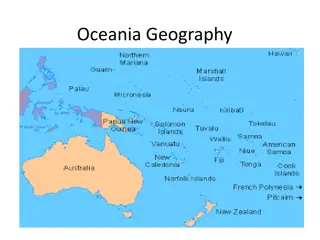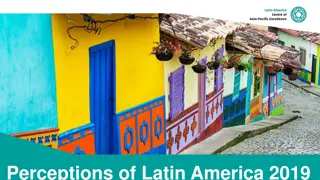The Maori People of New Zealand: History and Culture
The Maori people were the first inhabitants of New Zealand, arriving around AD 1250-1300 from Eastern Polynesia. They lived in settlements called "pa" led by chiefs, with ceremonial meeting houses known as "wharenui". The Maori were hunter-gatherers, skilled in hunting moa birds and fishing. They practiced the art of tattooing (T moko) and traditional dances like poi. Today, many New Zealanders are descendants of European settlers, but the Maori culture remains an essential part of the country's heritage.
Download Presentation

Please find below an Image/Link to download the presentation.
The content on the website is provided AS IS for your information and personal use only. It may not be sold, licensed, or shared on other websites without obtaining consent from the author. Download presentation by click this link. If you encounter any issues during the download, it is possible that the publisher has removed the file from their server.
E N D
Presentation Transcript
The Maori Many New Zealanders today are descendants of European settlers, but the Maoripeople were the country s first inhabitants.
Origins of the Maori The Maori arrived on in New Zealand around AD 1250 1300. They came from the islands of Eastern Polynesia. Before the first European settlers arrived in AD 1642, they were New Zealand s only inhabitants. They named New Zealand Aotearoa, meaning Land of the Long White Cloud .
Settlements A pa was a Maori village. It was reinforced with deep trenches and wooden fences. Settlements were built close to a forest, the sea or a river. Over 5,000 settlements have been discovered, mainly on the North Island. The Maori lived in large tribes. Each tribe (iwi) was led by a chief (ariki).
Settlements A wharenui was a community meeting house for holding ceremonies and entertainment. The building was decorated with intricate carvings representing the community s ancestors.
Settlements A wooden mask was placed above the entrance to the wharenui. These masks mimicked the expression made by a warrior during a war dance. They were also covered in intricate line carvings to resemble facial tattoos.
Food The Maori were hunter-gatherers. They hunted a large flightless bird (similar to an ostrich) called a moa until it became extinct. They were skilled fishermen, so seafood was a big part of their diet. The land was covered in forests that provided them with a source of berries, fruit, seeds and mushrooms. The Maori also grew some plants such as yams. Animals such as the Polynesian rat and Polynesian dog, which they introduced to New Zealand, were killed for their meat.
The art of tattooing T moko is the traditional Maori art of tattooing. They covered their faces in tattoos to scare their enemies. Each tattoo showed an individual s heritage and status within the tribe. Nowadays, some Maori still get facial tattoos to honour their ancestors.
The art of dance Maori women learned to perform a dance known as poi, using graceful wrist movements to swing small, light balls suspended on strings.
The art of dance Traditionally, the haka dance was performed only by men. Warriors performed it at the start of a battle to give them courage and strength and frighten their opponents.
Beliefs The Maori believed that there were two gods: Rangi (Father Sky) and Papa (Mother Earth). Together, they created all things in the universe. They had over 70 children, who became the gods of the Maori. All were gods of nature, such as T whirim tea, god of wind and storms, whose children were the gods of rain, hail and clouds.
Beliefs Before the arrival of European settlers, the Maori had no written language. Their myths and legends were kept alive as stories told by the elders, and depicted in wood carvings. A demigod (the child of a god and a human being) named Maui appears in many of the legends and uses his magical powers to trick the other gods.
Illustrations Shutterstock Beehive






















